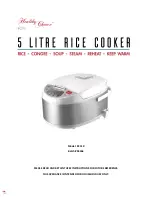
5
Fig. C
Condensation
collector
Push
lines
Steam vent
Vent slots
HElPFUl HINTS
• If desired, white rice may be rinsed in cold water prior to cooking. Rinsing makes rice less sticky by removing some
of the starch. Rinse rice in another bowl or colander until water is clear. Brown rice, which has the bran intact, does
not benefit from rinsing.
• Like other rice cookers, the cooked rice that is in contact with the bottom of the rice pot will have a light brown,
crust-like appearance. This is normal. This brown crust may be minimized with white rice if you soak the rice prior to
cooking.
• Rice can be flavored by using a combination of water and broth or broth alone. If broth is substituted for water, use
the same amount of broth as you would water.
• Brown rice requires more water and takes longer to cook than white rice. See the special instructions for cooking
brown rice on page 3.
• Different rices cook up moister and softer than others. In addition, firmness of the rice is a matter of personal
preference. Water amounts may be adjusted to achieve desired texture. Try adding (for softer rice) or reducing (for
firmer rice) water in 2 tablespoon increments for each scoop of rice cooked until the rice is to the desired moisture
level. Never exceed the “MAX” fill level.
• For flavorful rice pilafs or casseroles, sauté your favorite chopped veggies with desired spices in a small amount
of vegetable oil in a skillet until veggies are translucent and tender. Follow steps 3 and 4 of the “To Cook Rice”
instructions (see pages 2 and 3), add the sautéed veggies, and proceed with steps 5 through 10.
• To prevent loss of steam and heat, do not open the rice cooker during cooking. The exception is when it is necessary
to add food for steaming.
• A kitchen timer is very helpful if you want to know approximately when the rice will be ready to serve. Simply set
the timer for the maximum cooking time and add 10 minutes for the warming period.
• The rice paddle fits into the rice paddle holder for convenient stirring, serving, and storing. Insert the paddle so the
indented scoop side is towards the rice cooker.
CARE AND ClEANING
1. Remove plug from wall outlet and allow rice cooker to cool completely before cleaning.
2. Remove the rice pot. Wash it in warm water and a mild detergent. Rinse and dry thoroughly. The rice pot may be
washed in a dishwasher; however, because it is made of anodized aluminum, the outside of the pot will discolor due
to the caustic nature of the dishwashing detergent. Do not use steel wool scouring pads or abrasive cleansers on the
rice pot or on the rice cooker base.
Important:
Always make sure the rice pot is completely dry before placing it back into the rice cooker base. Placing
a wet rice pot into the rice cooker may damage the unit and cause it to malfunction.
3. The steaming basket, measuring scoop, and rice paddle may be washed in a dishwasher or in hot, soapy water.
4. Wipe the inside of the cover and the interior and exterior of the rice cooker base with a soft, damp cloth. Dry
thoroughly with a soft cloth. DO NOT IMMERSE RICE COOKER BASE IN WATER OR OTHER LIQUID.
5. Remove the condensation collector on the side of the base (Fig. C); it collects
condensation from the rice cooker cover when the cover is opened after cooking.
Push the two lines on the lower portion of the collector. Then grab the sides of
the collector and pull it out from the base. Empty any moisture that has collected.
Wash the collector and reinsert it into the rice cooker base by fitting the two
grooves on the sides of the collector over the tabs on the rice cooker base. Then
push the collector back into position. Note: At times there may be no moisture or
very little moisture in the collector. The amount of moisture will depend on how
much condensation is remaining on the cover when it is opened.
6. After each use, pull the steam vent out of the rice cooker cover.
While holding the vent in both hands, turn the cap counterclockwise to
disassemble it from the vent chamber. Wash the cap and chamber in hot, soapy
water. Do not remove the rubber disk on the bottom of the vent chamber.
7. Reassemble the cap portion to the vent chamber. Reinsert the vent into the rice cooker cover so the vent slots are
towards the outer edge of the cooker.
























